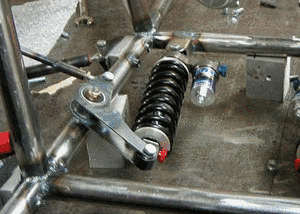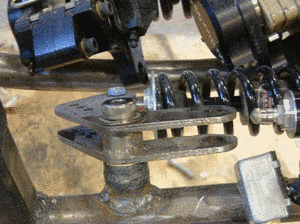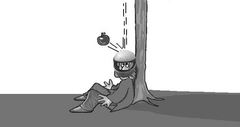Hello again,
one month closer to FSG and with FSAE at Detroit only a month away. Good luck and best wishes to all the FSG regulars who are competing in the USA this year.
We wish you well and hope you bring the Neil Schilke Trophy to Europe for the first time.
Isaac Newton, Race Engineer
Isaac Newton was born in the UK in the 17th century. He is credited with discoveries in many facets of science and is arguably one of the most brilliant minds of all time. Many of his discoveries are in daily use over 300 years later and probably will still be in use in another 300 years.
As engineers we are all familiar (or should be) with his three laws of motion.
- Every object in a state of uniform motion tends to remain in that state of motion unless an external force is applied to it.
- The relationship between an object's mass m, its acceleration a, and the applied force F is F = ma. Acceleration and force are vectors (as indicated by their symbols being displayed in slant bold font); in this law the direction of the force vector is the same as the direction of the acceleration vector.
- For every action there is an equal and opposite reaction.
So, if Isaac Newton was alive today, how would he relate these laws to construction and maintenance of a racecar.
Where would rule one be relevant to your FSG car?
Maybe the question should be “where is it not relevant?”!
Every part of the car that is in motion, including the entire car, is affected by Newton’s First Law.
Let us assume the car is in constant motion, like on the main straight. What do we want to do next? Slow the car down? Turn the car? Both? If so, what is the external force applied to achieve this?
Let us think about slowing down. The external force applied comes from increased friction between the tyres and the road. The wheels will continue to rotate unless an external force is applied, that force being applied by the brake pads. You can trace that force back to the drivers back pressing against the seat back, then to the seat mounting in the frame.
The driver controls the level of force by how hard he presses on the brake pedal. Eventually enough force will be applied to stop the wheel rotating, but if insufficient friction is not generated at the tyre contact patch, Newton will ensure the car slows down only by the amount of force being applied by the tyres, and with them stopped, melting and gassing, that will not be very much.
So, Newton would maximize all facets of the braking control loop to get the car slowed for the upcoming corner.
Then what happens? Newton dictates the car will continue in a straight line unless a side force is applied, and this comes from the force generated at the tyre contact patch when the driver turns the wheel. Again, this is controlled by the driver, and again is limited by the friction available between tyre and ground. If that friction has been degraded during the braking phase, then there will be little friction left to apply the side force. The problem will be worse if the driver is ‘trail-braking’ that is turning and braking at the same time.
This introduces the concept of the ‘Friction Circle’ but that is a topic for another day.
I guess if we think about Newton’s First Law, all vehicles are fundamentally understeerers, as they really want to go straight ahead……But then when we get the steered front wheels deviating, the rear of the car will attempt to keep traveling in the same direction, thereby oversteering.
The intent of this article is not to explain the secrets of the Universe (even if I could) but to challenge you to think about how old Isaac’s ideas relate to vehicle design.
Okay, let’s move on to the second law, usually quoted as F=MA (or A=F/M if you like)
That’s the one that explains why your car will accelerate faster if it weighs less. Then think about what needs to be accelerated (or decelerated).
Anything you can do to optimize your car according to F=MA will make you go faster!
A lighter car will accelerate and decelerate quicker than a heavier car, all other things being equal. Similarly it will turn quicker.
Lighter pistons or flywheels will permit faster engine response. The list is almost endless. This law is one that should be foremost when designing and building the car. Less mass while still getting the job done is always a good thing!
When building the car it is easy to take the easy way out and let little things slip. An added bracket here, a duplicated tube there, a thicker wall material than is necessary gets used and suddenly the entire weight of the vehicle has added up.
This shows the relationship between the First and Second Laws. A change in mass will react in a different manner to the force applied.
What about the Third Law? For every action there is an equal and opposite reaction! Wow, isn’t that one important! Yet so often overlooked by teams in almost every facet of the competition!
The obvious interpretation of Newton’s Third Law relates to the reaction between tyres and ground in acceleration, braking and turning, however, it doesn’t end there.
The judges will look at how you react the various forces into the chassis. These forces include the ones we hope you never experience, that is the forces generated in a crash.
You need to look hard at where all the forces go, that is to understand the load paths. Time after time we see nicely made wishbones, feeding nicely made pushrods and bellcranks with the spring forces reacted in a nice solid chassis node…But the bellcrank is mounted in torsion halfway down an unsupported tube! The designer obviously hadn’t paid attention to Newton’s Third Law!
Some forces in the car are much higher than you might suspect. One is the brake torque generated around the front spindle. Another is the force applied to a brake pedal by a frightened driver! Probably 4 out of every five cars will show pedal or mounting deflection when the pedal is pushed hard! Not only has the driver’s effort been somewhat wasted, the eventual destination of that force…..to apply an external force to a body in motion. So, here the Third Law relates back to the First Law!
So, if Isaac Newton was a racecar designer/developer and diligently applied each of his three Laws of Motion, then his cars would be absolutely unbeatable! It is your job to emulate him!
Just to finish off. A quick perusal of the above document will show a common denominator when talking about all three (related) Laws. That common denominator is the tyre. This accentuates what we should already know, that the choice of tyre is critical.
This Months Design Error
Obviously, my Design error of the month has to relate to a misunderstanding of one of Newton’s Laws, in this case the Third Law.

Look where the bell-crank and spring loads are being reacted! Judges look at a design like this, they can see the load paths and they eliminate the car from the Design Finals!
Now take a look at this load path. Isaac Newton turned in his grave just a couple of minutes before the frame broke.

Enough for this month. Keep safe and I look forward to seeing everyone in August.
Cheers

Pat


